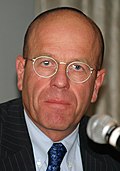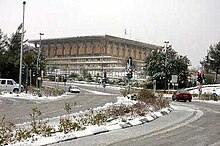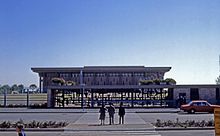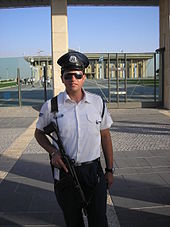Knesset
| logo | Parliament building |
|---|---|

|
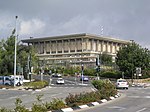
|
| Basic data | |
| Seat: | Jerusalem |
| Legislative period : | 4 years |
| MPs: | 120 |
| Current legislative period | |
| Last choice: | March 2nd, 2020 |
| Chair: |
President of Parliament Yariv Levin ( Likud ) |
|
|
| Distribution of seats: |
|
| Website | |
| knesset.gov.il | |
The Knesset ( Ivrit כנסת"Assembly") is the unicameral parliament of the State of Israel in Givat Ram, Jerusalem . It consists of 120 members who are elected for a legislative period of four years using proportional representation with a threshold of 3.25 percent. The Knesset met for the first time on February 14, 1949. The election for the 24th Knesset took place on March 23, 2021.
prehistory
The name Knesset and the number of 120 MPs are derived from the Knesset Ha-Gdola , the Grand Assembly as described in the Bible in the book of Nehemiah . This Jewish council met in the 5th century BC. Under Ezra and Nehemiah in Jerusalem, that is, after the return of the Jews from Babylonian exile .
Organization and practices of the Knesset are strongly influenced by the Zionist congresses of the Zionist Organization World influences. Loans were also borrowed from the Yishuv Palestinian Parliament during the mandate ; in addition, the British House of Commons served as a model for the rules of procedure.
The Provisional Council of State began its work on May 14, 1948, the day of the declaration of independence . It served as legislature and executive until elections could be held. The provisional council of state consisted of 38 members and 27 deputies, its president was Chaim Weizmann . A provisional government was also formed under David Ben-Gurion .
The War of Independence initially prevented the planned elections , which were not held until January 25, 1949, nine months after the declaration of independence .
On 15 Shevat 5709, on Tu biShevat , the New Year of the trees according to the Jewish calendar , that is February 14, 1949, the Constituent Assembly finally met. On February 16, the congregation named itself “Knesset”.
Electoral system
The 120 MPs are elected for four years. Every citizen older than 18 years is entitled to vote. You can be elected from the age of 21. Since 1985 it has been stipulated by law that no one can be elected who denies Israel's right to exist or takes up racist positions. On October 31, 2007, the Knesset passed a law whereby the right to stand can be withdrawn if a hostile country has been visited without permission.
The whole country forms a common constituency. Most parties hold primaries. Parties that overcome the threshold clause , which was increased from 2% to 3.25% on March 11, 2014 , are allocated seats from a rigid list based on the principle of proportional representation using the divisor procedure with rounding off. This maximum number method according to d'Hondt is called the Bader-Ofer method in Israel.
Parties can enter into list connections in which no more than two lists may be involved. In this case, their votes are added together for the distribution of seats, provided that both of them overcome the threshold clause. Within the list connection, the seats are allocated according to the Bader-Ofer procedure ( D'Hondt procedure ).
The low threshold, which was only 1 percent up to 1988, 1.5 percent from 1992–2003 and 2 percent from 2006–2013, means that many and heterogeneous parties are represented in the Israeli parliament. Usually more than ten list connections are represented in the Knesset. Only once, in the eighth Knesset from 1973 to 1977, there were only nine parliamentary groups.
The Knesset is re-elected every four years. Early elections can be held if parliament dissolves itself by a special law with a simple majority and fixes a new election date, if the budget law is not passed within a specified period, or if the president dissolves parliament on the recommendation of the prime minister.
Election results and distribution of seats
- Election results since 1949:
- Distribution of seats according to session periods:
Competences and legislative activity
The Knesset has the right to dissolve itself and, on the other hand, can determine an extension of the legislative period. The Knesset elects the President and the Ombudsman and can vote out both if necessary.
The Knesset operates in plenary sessions and in twelve standing committees:
- House Committee
- Foreign Policy and Security Committee
- Budget Committee
- Economic Committee
- Committee on Home Affairs and the Environment
- Education and Culture Committee
- Labor and Social Committee
- Constitutional and Legal Committee
- Immigration and Inclusion Committee
- State Control Committee
- Substance Abuse Committee
- Committee for the Improvement of the Status of Women
In the plenary sessions, debates are held on the work of the government and the proposed bills are discussed. The debates of the Knesset are generally conducted in Hebrew, but also in Arabic on request, and simultaneous translation is available.
To become law, a bill has to pass three readings in the Knesset. Every Knesset member, the government and the Knesset committees can introduce laws into parliament. Initiatives by individual members of parliament have to go through an additional preparatory reading beforehand. During the first reading, the draft law is presented to the MPs in the plenary session. This is followed by a brief substantive debate, after which the draft is referred to the responsible Knesset committee. There it is discussed in detail and revised if necessary. When the committee has finished its work, the draft will come back to plenary for a second reading. Committee members who have objections to the draft can raise these in the plenary session. After a general debate, each article of the bill will be voted on. If the legislative initiative is not referred back to the committee, the third reading takes place immediately afterwards, in which the bill as a whole is voted on. If the bill is passed, it is first signed by the Speaker of Parliament. This is followed by the signature by the President, the Prime Minister and the responsible minister. It is then published in the government bulletin and finally issued by the Minister of Justice.
An action can be brought against a law that has been passed before the Supreme Court . The Supreme Court examines the constitutionality of a law and, if necessary, can declare it invalid.
Members of the Knesset
Knesset MPs enjoy life-long personal immunity from prosecution. During your term of office, your house or office may not be searched, with the exception of customs controls. They are also protected from arrest unless they commit a violent crime, disturbance of the peace, or treason. Immunity can be waived by the Knesset.
A member of the Knesset can resign from office. He must notify the President of Parliament of his resignation in writing. The resignation becomes valid 48 hours after it is presented to the President of Parliament, unless it is revoked in writing beforehand. The Knesset can withdraw a convicted MP with a two-thirds majority if he has been sentenced to at least one year in prison. Resigned members are replaced by candidates from the same party.
During their term of office, the MPs are not allowed to engage in any business or professional activity.
President of Parliament
The sessions of the Knesset are chaired by the Speaker of Parliament (“Speaker”). This is elected by the members of the Knesset in the first session after an election. He conducts the business of the Knesset, sets its agenda, represents it externally and monitors compliance with the rules of procedure. The President of Parliament or one of his deputies chair the plenary sessions, schedule voting dates and determine voting results. In the absence of the President , the President of Parliament takes over his functions.
1949–1959: Yosef Sprinzak , Mapai
1959–1959: Nahum Nir , Achdut haAwoda
1959–1969: Kadish Luz , Mapai / Awoda
1969–1972: Reuven Barkat , Awoda
1972–1977: Yisrael Yeshayahu-Sharabi , Awoda
1977-1980: Yitzhak Shamir , Likud
1980-1981: Yitzhak Berman , Likud
1981-1984: Menachem Savidor , Likud
1984–1988: Schlomo Hillel , Awoda
1988-1992: Dov Shilansky , Likud
1992–1996: Schewach Weiss , Awoda
1996-1999: Dan Tichon , Likud
1999–2003: Avraham Burg , Awoda
2003-2006: Reuven Rivlin , Likud
2006–2009: Dalia Itzik , Kadima
2013–2020: July-Joel Edelstein , Likud
2020-2020: Benny Gantz , Chosen LeJisra'el
2020: Yariv Levin , Likud
Parliament building

Beth ha-Knesset
The Knesset holds its meetings in its own building, the Beth ha-Knesset , in Hebrew for House of Assembly in the Giwat Ram district of Jerusalem . The location of the parliament is based on urban planning for an Israeli government district, which goes back to the "Rau Plan" of 1949 named after Heinz Rau . The building was planned by the architect Joseph Klarwein and has been the seat of parliament since August 30, 1966. The building was financed by the Baron James de Rothschild Fund. It was built on leased land from the Greek Orthodox Patriarchate of Jerusalem . The typical 1960s building combines constructivist elements with a few classicist elements. The square column structure is made of concrete and the reddish Jerusalem stone . The interior of the building was kept quite simple by Dora Gad .
The Chagall Hall deserves special attention: at the invitation of Kadish Luz , the then Speaker of the Knesset, Marc Chagall designed three large tapestries (measuring 5.50 by 4.80 meters for the two smaller outer ones and 9.50 by 4, 80 meters for the middle carpet), on which he deals with biblical and modern topics from the history of the Jewish people. Originally, windows were planned to be similar to those in the Hadassah Medical Center in En Kerem , but Chagall offered to make carpets, although he had never worked with such a material before. As titles, Chagall suggested "The End of Days", "Moses, King David and the Dispersions" and "The Rebirth of the State of Israel" and Kadish Luz named Chagall verses from the Bible that he wanted to be processed. Many of these verses appear in the motifs of the tapestries, which today bear the names "Isaia's Vision" or "Peace", "The Exodus from Egypt" and "The Entry to Jerusalem" or "Return to Zion". The designs for the tapestries were completed by Chagall in 1963 and 1964, respectively, the subsequent execution was taken over by the Parisian "Atelier de la Manufacture des Gobelins" and completed in 1968. The motif of the tapestry with the title “Isaia's Vision” was adopted with only minimal deviations for a glass window in the UN building in New York.
In the hall there is also a Chagall wall mosaic , which was implemented by Italian artists with Israeli and Italian natural stones, as well as several Chagall floor mosaics. A copy of the Israeli Declaration of Independence can also be viewed in this room . Black and white photographs by the Knesset's official photographer, David Rubinger, are exhibited throughout the building .
In front of the Knesset there is a large, bronze seven-armed candlestick - the Knesset menorah . It was designed by Benno Elkan . The menorah, almost five meters high and weighing 4 tons, was a gift from the British Parliament. 29 important topics and events in Jewish history are depicted on its seven arms.

In 1992 another wing was added, which is mainly underground so as not to disturb the overall picture. Another extension is planned.
On March 30, 2015, the approximately 1,500 solar modules on the roof of the Knesset were officially put into operation. The solar cell group produces 10% of the previous electricity demand for the Knesset. Together with other measures of the "Green Knesset" project such as the installation of LED lamps , the coupling of cooling systems with hot water heaters, the use of wastewater for watering the garden and a general overhaul of the irrigation system, the energy requirement should be reduced by a third. In addition to financial savings of annually some 1.5 million shekels (344,000 euros) Parliament will these measures its CO 2 footprint significantly smaller.
Previous meeting places
The first session of the constituent assembly from February 14, 1948, was held in the Jewish Agency building in Jerusalem. Between March 8, 1949 and December 14, 1949, people met in various halls in Tel Aviv due to the war. From December 26, 1949 to March 8, 1950, the seat of the Jewish Agency in Jerusalem was again the meeting place of the Knesset. Before moving into the new building in Giwat Ram (Jerusalem) on August 30, 1966, the Froumine House on King George Street in Jerusalem was home to Parliament for more than 16 years.
Significant events in the Knesset
2020-2029
- December 23, 2020: Because the government coalition ( Cabinet Benjamin Netanyahu V ) cannot agree on a budget by December 22, 2020, parliament will automatically be dissolved at midnight and new elections will be scheduled on March 23, 2021 .
- March 2, 2020: Election to the 23rd Knesset .
2010-2019
- September 17, 2019: Election to the 22nd Knesset .
- April 9, 2019: Election to the 21st Knesset .
- March 17, 2015: Election to the 20th Knesset .
- June 10, 2014: Reuven Rivlin is elected 10th President .
- January 22, 2013: Election to the 19th Knesset .
2000-2009

- February 10, 2009: Election to the 18th Knesset .
- March 18, 2008: A foreign head of government speaks for the first time in the Knesset with German Chancellor Angela Merkel .
- December 3, 2007: Commemorative meeting on the 60th anniversary of the UN partition plan .
- June 13, 2007: Election of Shimon Peres as 9th President .
- April 22, 2007: The Knesset member Azmi Bishara of the Balad party submits his resignation after he had left the country on April 8 of 2007. He is said to have carried out espionage during the Second Lebanon War .
- January 29, 2007: The Knesset confirms the first appointment of an Arab minister: Raleb Majadele becomes minister without portfolio .
- March 28, 2006: Election to the 17th Knesset .
- November 23, 2005: Prime Minister Sharon and 13 other Knesset members leave Likud and found the Kadima party .
- February 2, 2005: Federal President Horst Köhler speaks in the Knesset on the occasion of the 40th anniversary of diplomatic relations .
- June 29, 2004: The Knesset declares the 10th Ijar , Theodor Herzl's birthday , to be the official Herzl Day.
- January 28, 2003: Election to the 16th Knesset .
- October 17, 2001: Knesset member Rechaw'am Ze'ewi is murdered by terrorists from the Popular Front for the Liberation of Palestine .
- September 16, 2001: Memorial session for the victims of the terrorist attacks on September 11, 2001 in the USA .
- March 7, 2001: Amendment to the Basic Law: Abolition of the direct election of the Prime Minister .
- July 31, 2000: Election of Moshe Katzav as 8th President .
- May 25, 2000: Plenary session in Rosh Pina in solidarity with the inhabitants of northern Israel and the soldiers on the border with Lebanon.
- February 16, 2000: The German President Johannes Rau is the first German politician to speak in the Knesset. It is also the first speech given in German .
1990-1999
- May 17, 1999: Election to the 15th Knesset .
- May 29, 1996: Election to the 14th Knesset .
- November 4, 1995: Assassination of Prime Minister Yitzhak Rabin .
- September 23, 1993: Approval of the agreement on Palestinian autonomy with 61 votes in favor, 50 against, with eight abstentions.
- May 13, 1993: Election of Ezer Weizmann as 7th President .
- June 23, 1992: Election to the 13th Knesset .
- March 18, 1992: Amendment to the Basic Law: direct election of the Prime Minister .
- March 17, 1992: Amendment to the Basic Law: freedom of career choice, protection of human dignity.
- May 20, 1991: Polish President Lech Wałęsa speaks to the Knesset and asks forgiveness for the behavior of the Polish people during the Holocaust .
1980-1989

- November 1, 1988: Election to the 12th Knesset.
- February 15, 1988: Amendment to the Basic Law: Ombudsman .
- July 31, 1985: Amendment to the Basic Law: Parties can be excluded from elections if they attack the existence of the State of Israel, fight its democratic constitution or incite racism .
- July 23, 1984: Election to the 11th Knesset.
- March 22, 1983: Chaim Herzog is elected 6th President .
- March 4, 1982: President François Mitterrand speaks in the Knesset.
- December 14, 1981: annexation of the Golan Heights .
- June 30, 1981: Election to the 10th Knesset.
- January 12, 1981: The Bedouin Sheikh Hamad Abu Rabiah , member of the Knesset for the “United Arab List”, is murdered.
- December 13, 1980: Amendment to the Basic Law: Jerusalem's status as the undivided capital of the State of Israel.
1970-1979
- March 21, 1979: After a 28-hour debate, the Knesset votes with 95 for, 18 against and 2 abstentions for the Camp David peace treaty with Egypt .
- April 19, 1978: Election of Yitzhak Navon as 5th President .
- November 20, 1977: Egyptian President Anwar al-Sadat speaks in the Knesset.
- May 17, 1977: Election to the ninth Knesset.
- November 11, 1975: The President of Parliament speaks in the UN General Assembly and condemns resolution 3379 of November 10, 1975, in which Zionism is condemned as racism . Resolution 3379 was not withdrawn until December 16, 1991.
- May 3, 1975: Palestinian guerrillas fire two rockets at the Knesset building. Nobody is injured in the attack, there is only minor damage to property.
- May 20, 1974: Memorial session for the 22 victims of the Maalot attack .
- December 31, 1973: Election to the eighth Knesset.
- April 10, 1973: Ephraim Katzir is elected 4th President .
- September 12, 1972: Memorial meeting for the eleven victims of the kidnapping at the Olympic Games in Munich .
- May 18, 1970: David Ben Gurion resigns from office.
- February 3, 1970: Legal stipulation: A Jew is someone who was born of a Jewish mother or who converted to Judaism and does not belong to any other religion.
1960-1969
- December 28, 1969: Elections to the 7th Knesset.
- June 18, 1969: The Chagall Hall in the Knesset, named after Marc Chagall , opens.
- November 25, 1968: Memorial session for the 12 victims of the terrorist attack on Mahane Yehuda Market in Jerusalem .
- June 27, 1967: The Knesset passes laws to unify Jerusalem and protect the holy places.
- June 12, 1967: 1st solemn session of the Knesset in the reunited Jerusalem .
- August 20, 1966: The new Knesset building in Jerusalem's Givat Ram district is opened with a state ceremony.
- November 1, 1965: Elections to the sixth Knesset.
- May 18, 1965: Memorial meeting in honor of the spy Eli Cohen who was hanged in Damascus .
- March 16, 1965: The Knesset approves the government's decision to establish diplomatic relations with the Federal Republic of Germany .
- July 8, 1964: Solemn session of the Knesset in honor of Zeev Jabotinsky and his wife, who find their final resting place in Jerusalem.
- May 21, 1963: Election of Zalman Shazar as 3rd President .
- February 12, 1962: Finance Minister Levi Eshkol announces a stabilization of the economy, the central point is a devaluation of the shekel by 70 percent.
- August 15, 1961: Elections to the fifth Knesset.
- December 21, 1960: In a response to a parliamentary question, the government confirms that it has approved the construction of a nuclear reactor for research purposes .
- July 25, 1960: Amendment to the Basic Law: Land ownership.
- May 9, 1960: A solemn meeting in honor of Theodor Herzl's 100th birthday .
1950-1959
- November 3, 1959: Elections to the fourth Knesset.
- October 14, 1958: Foundation stone laid for the new Knesset building.
- April 22, 1958: Solemn meeting for ten years of independence.
- February 12, 1958: Amendment to the Basic Law: Knesset.
- October 29, 1957: A mentally disturbed man, whose motive is unknown, threw a hand grenade into the Knesset plenary . Religion Minister Moshe Shapiro was seriously injured, Prime Minister David Ben-Gurion and Ministers Golda Meir and Moshe Carmel were also injured. The event led to the establishment of a security service in 1959, stricter security measures and the installation of protective glass.
- December 12, 1956: The Prime Minister reports on Kafr Qasim in the Knesset .
- April 15, 1956: The menorah sculpture by the Jewish sculptor Beno Elkan is placed in front of the Knesset.
- July 26, 1955: Elections to the 3rd Knesset.
- February 21, 1955: Following the resignation of Pinchas Lawon as Secretary of Defense , David Ben-Gurion returns to politics as his successor.
- December 13, 1954: Prime Minister Moshe Sharett reports to the Knesset about the opening of a trial in Egypt against 13 Jewish people charged with espionage and a series of bombings in Cairo and Alexandria - the beginning of the Lawon affair .
- August 11, 1954: The Knesset lifts the immunity of one of its members for the first time . Mapai's Shlomo Lavie was involved in a traffic accident that killed a man.
- December 8, 1952: Election of Yitzchak Ben Zwi as 2nd President .
- January 21, 1952: Menachem Begin is excluded from Knesset meetings for three months because of his participation in the demonstrations against the opening of negotiations on reparations with Germany .
- January 9, 1952: The Knesset decides to start negotiations with the government of the Federal Republic of Germany on reparations for the admission, integration and medical care for Jews persecuted by the Nazi regime. The debate takes place outside the Knesset building after angry protests.
- July 30, 1951: Elections to the 2nd Knesset.
- July 5, 1950: The Law of Return is passed , giving every Jew the right to immigrate to Israel .
- June 13, 1950: Adoption of the Hariri Resolution, with which a constitution in the form of individual basic laws is to be built.
- March 13, 1950: The Knesset held its first meeting on King George Street.
- January 23, 1950: Decision to build a government building and a parliament building.
1948-1949
- December 26, 1949: 1st session of the Knesset in the Jewish Agency building in Jerusalem .
- December 5, 1949: The Knesset declares Jewish Jerusalem to be an integral and inseparable part of the State of Israel in response to the UN proposal that the city should be internationalized as planned in the UN partition plan for Palestine .
- August 16, 1949: Special session on the occasion of the burial of Theodor Herzl 's remains on Mount Herzl in Jerusalem.
- April 26, 1949: The Knesset passes resolutions on immigration, an austerity policy and the rationing of basic needs .
- February 17, 1949: Inauguration of the 1st Knesset by President Chaim Weizmann .
- February 16, 1949: The transitional law is passed. The founding assembly becomes the first Israeli parliament, the Knesset. Chaim Weizmann is elected as the first President of the State of Israel .
- February 14, 1949: The founding assembly meets in Jerusalem under the chairmanship of the President of the Provisional Council of State, Chaim Weizmann .
- January 25, 1949: The first elections for the founding assembly.
- May 14, 1948: The Provisional Government under David Ben-Gurion meets. The will of independence in the home of former Mayor Dizengoff proclaimed in Tel Aviv.
See also
Web links
- The Knesset. official website. In: knesset.gov.il. Retrieved December 20, 2018 . (Hebrew, English, Arabic, Russian)
- Literature by and about the Knesset in the WorldCat bibliographic database
Individual evidence
- ↑ Knesset passes governance laws; electoral threshold raised , March 11, 2014, accessed May 24, 2021.
- ^ Knesset - Lexicon of Terms : The Distribution of Knesset Seats Among the Lists - the Bader-Offer <sic!> Method , accessed May 24, 2021.
- ^ All Knesset Speakers. In: knesset.gov.il. Accessed December 20, 2018 .
- ↑ Jair Levin elected speaker of the Knesset. In: Israelnetz.de. Retrieved May 18, 2020 .
- ↑ Lily Galili: Defacement in Jerusalem Monastery Threatens Diplomatic Crisis. In: Haaretz.com. October 8, 2006, accessed December 20, 2018 .
- ↑ Newsletter of the Embassy of the State of Israel of March 23, 2015
- ↑ Legislature - The Knesset. In: mfa.gov.il. Israel Ministry of Foreign Affairs, January 2, 2002, accessed December 20, 2018 .
- ↑ Israel is facing new elections again. In: tagesschau.de . December 23, 2020, accessed December 27, 2020.
- ↑ Raoul Wootliff: Israel calls 4th election in 2 years as Netanyahu Gantz coalition collapses. In: The Times of Israel . December 23, 2020, accessed December 27, 2020.
Coordinates: 31 ° 46 ′ 36.1 ″ N , 35 ° 12 ′ 18.7 ″ E













